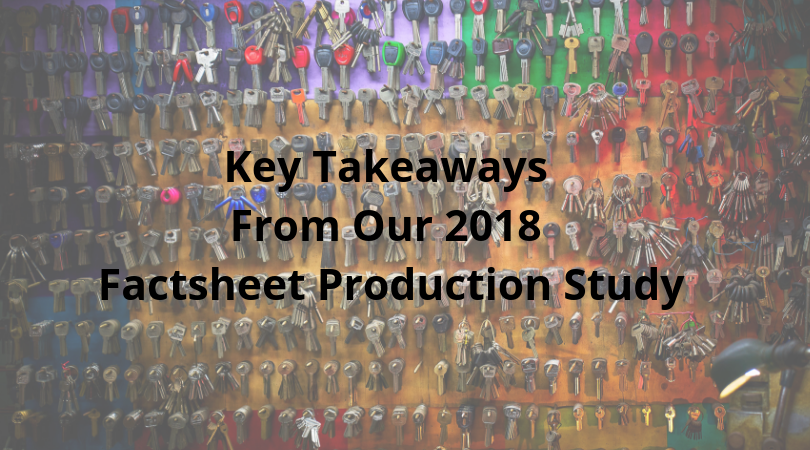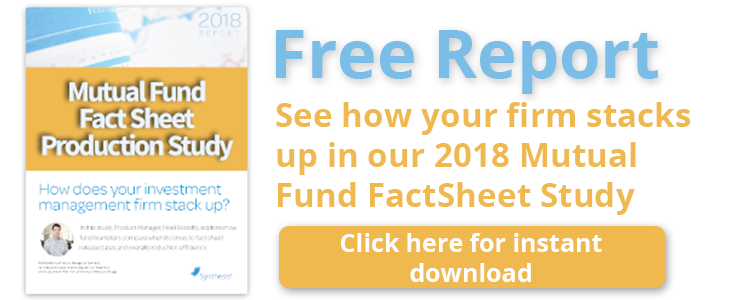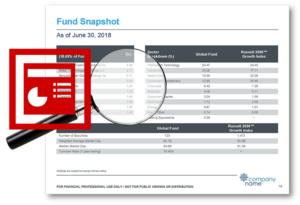Key Takeaways From Our 2018 Factsheet Production Study

In 2018, we conducted a Mutual Fund Fact Sheet Production Study, where we analyzed 235 factsheets from 47 asset management firms of all shapes and sizes. A few factors observed included publish date, modification date and how the file was produced. The two most observed methods were using automation and producing factsheets manually. To find the firm’s production method, we turned to the metadata to show us what applications, software, or tools they were using to create the PDFs. After digging deeper into the metadata, we identified some key reasons why firms have longer production durations or later release dates. We were also able to make some observations about what drives efficiency, and the findings were pretty shocking. Read on to get the scoop!
Firms Producing Factsheets Manually Have Later Start Dates
Does the early bird really get the worm? If worms are inflows, we’d say yes. Time-to-market can be a key competitive advantage for asset management firms. Yet, a slew of firms struggle to hit their production goals. In many cases, firms struggle to hit these goals due to later start dates. In our study, we found manual firms generally started production later than automated firms. Unsurprisingly, 63% of firms that produced manually started after the 10th business day, whereas only 31% of those who used automation started after the 10th business day. In our opinion, the data clearly illustrates automation can help firms increase time-to-market, in turn, increasing their AUM.
Automation Alone Doesn’t Guarantee Efficiency
If automation improves time-to-market, it should also improve efficiency, right? We thought so, too, but the answer was not necessarily. We found 41% of automated firms had longer duration periods than the industry average, while manual firms were at 39%. By these numbers, we don’t see a clear advantage of using automation. To make sense of this phenomenon, we looked at what systems were producing these documents. The automated factsheets were being produced with a variety of different systems, from proprietary software to Microsoft-based solutions. We also found some of the automated factsheets had modification dates after the initial publish date. We can assume, in many of these cases, an error was found and had to be corrected. The data led us to the conclusion that the reason duration periods were so high in firms that automated their factsheets was because not all automation solutions create more efficiency.
Not All Automation Solutions Are Created Equally
Though firms that automated had higher overall production efficiency, the data showed us not all automation solutions are successful at creating efficiency. As stated above, duration periods were longer than the industry average in almost half of firms that automated, but why? By investigating further, we discovered longer durations were related to firms using Microsoft PowerPoint or Word to automate their factsheets. This was very interesting to us because, in another research study we conducted earlier this year, several investment marketers reported seeing limitations with PowerPoint-based systems. Specifically, these marketers experienced production delays due to data integration issues during implementation and quarterly production cycles. Because of this, concluded factsheet production efficiency greatly depends on the quality of the automation solution and how it was implemented.
Conclusion
Automation did prove to be a more efficient way to produce factsheets. However, efficiency relies on many factors, including the automation solution and vendor’s approach. Asset management firms looking for a top of the line solution will have to look beyond fancy pitches or attention grabbing low prices. For a better ROI over the long haul, firms must carefully consider their approach to automation, given their internal resources and budget. We strongly believe success lies in selecting the right vendor. When the right approach is implemented, time-to-market and duration periods will decrease while efficiency increases. For more information on factsheet production, download the full Mutual Fund Factsheet Production Study or contact us. Until next time, thanks for reading and I hope this was helpful!
Here are some related resources that might interest you:








 Compare the Top 3 Finserv Content Automation Vendors [White paper]
Compare the Top 3 Finserv Content Automation Vendors [White paper] Create Pitchbooks the Drive Sales [White paper]
Create Pitchbooks the Drive Sales [White paper] Build vs. Buy: Should Your Financial Services Firm Outsource or Insource Marketing Technology? [White paper]
Build vs. Buy: Should Your Financial Services Firm Outsource or Insource Marketing Technology? [White paper]  10 Tips for Rebranding your Fund Marketing Documents [White paper]
10 Tips for Rebranding your Fund Marketing Documents [White paper]



